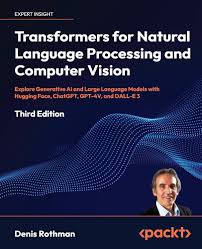Transformers for Natural Language Processing and Computer Vision: A Comprehensive Guide
This white paper explores the transformative impact of Transformer models on Natural Language Processing (NLP) and Computer Vision, drawing insights from advanced resources like "Transformers for Natural Language Processing and Computer Vision - Third Edition."
1. Introduction
Transformer models, with their attention mechanism, have revolutionized deep learning, achieving state-of-the-art results across various domains. This white paper delves into the core principles of Transformers, their applications in NLP and Computer Vision, and their potential for future advancements.
2. Core Concepts of Transformers
- Attention Mechanism: The cornerstone of Transformers, allowing the model to weigh the importance of different parts of the input sequence when processing information.
- Self-Attention: Enables the model to attend to different parts of the input sequence itself, capturing long-range dependencies.
- Multi-Head Attention: Allows the model to learn multiple representations of the input sequence, capturing different aspects of the information.
- Encoder-Decoder Architecture: A common architecture for many Transformer models, where the encoder processes the input sequence, and the decoder generates the output sequence.
3. Transformers in Natural Language Processing (NLP)
- Language Modeling:
- GPT (Generative Pre-trained Transformer): A powerful language model capable of generating human-like text, translating languages, and writing different kinds of creative content.
- BERT (Bidirectional Encoder Representations from Transformers): A bidirectional language model that excels at various NLP tasks, including question answering, text summarization, and sentiment analysis.
- Machine Translation: Transformers have significantly improved the accuracy and fluency of machine translation systems.
- Text Summarization: Transformers can effectively generate concise and informative summaries of long documents.
- Sentiment Analysis: Accurately classify the sentiment expressed in text, such as positive, negative, or neutral.
- Chatbots and Conversational AI: Powering advanced chatbots with human-like conversational abilities.
4. Transformers in Computer Vision
- Image Recognition: Transformers have achieved impressive results in image classification, object detection, and image segmentation tasks.
- Object Detection: Accurately locate and classify objects within images.
- Image Captioning: Generating descriptive captions for images.
- Video Analysis: Analyzing and understanding video content, including action recognition and video summarization.
5. Advanced Transformer Architectures
- Vision Transformers (ViT): Apply the Transformer architecture directly to image data, achieving state-of-the-art results in various computer vision tasks.
- Hybrid Models: Combine Convolutional Neural Networks (CNNs) with Transformers for enhanced performance in computer vision tasks.
6. Use Cases and Applications
- Customer Service: Powering chatbots, sentiment analysis of customer feedback, and improving customer support experiences.
- Healthcare: Assisting in medical image analysis, drug discovery, and personalized medicine.
- Finance: Detecting fraud, analyzing market trends, and providing personalized financial advice.
- Autonomous Vehicles: Enabling self-driving cars to perceive and understand their surroundings.
- Natural Language Understanding: Powering advanced language understanding capabilities in search engines, virtual assistants, and other applications.
7. Challenges and Future Directions
- Computational Cost: Transformers can be computationally expensive to train and deploy.
- Interpretability: Understanding the inner workings of Transformer models remains an ongoing challenge.
- Bias and Fairness: Addressing bias and ensuring fairness in Transformer models is crucial for ethical and responsible AI.
- Continual Learning: Enabling Transformers to continuously learn and adapt to new data and changing environments.
8. References
- "Attention Is All You Need" (Vaswani et al., 2017) - The seminal paper introducing the Transformer architecture.
- "BERT: Pre-training of Deep Bidirectional1 Transformers for Language Understanding" (Devlin et al., 2018)
- "Vision Transformers: Image Recognition with Image Embeddings" (Dosovitskiy et al., 2020)
- "Deep Learning" by Ian Goodfellow, Yoshua Bengio, and Aaron Courville
- "Hands-On Machine Learning2 with Scikit-Learn, Keras & TensorFlow" by Aurélien Géron
- Hugging Face Transformers Library: https://huggingface.co/ - A popular open-source library for working with Transformer models.
- Papers with Code: https://paperswithcode.com/ - A platform for finding and exploring state-of-the-art machine learning research.
9. Conclusion
Transformers have revolutionized the fields of NLP and Computer Vision, demonstrating remarkable performance across a wide range of tasks. As research continues to advance, we can expect to see even more innovative applications of Transformers in the years to come, shaping the future of artificial intelligence.
Disclaimer: This white paper provides a general overview of Transformers and their applications. The specific implementations and advancements in this field are constantly evolving.
This information is for general knowledge and informational purposes only.
Disclaimer: This information is for general knowledge and informational purposes only.



